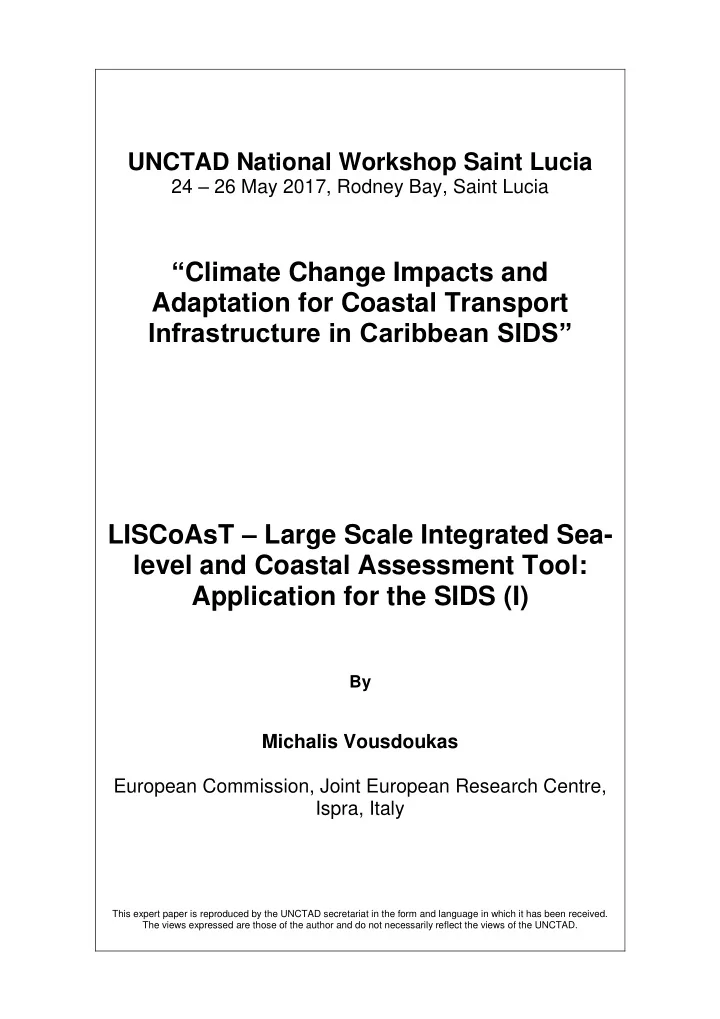

UNCTAD National Workshop Saint Lucia 24 – 26 May 2017, Rodney Bay, Saint Lucia “ Climate Change Impacts and Adaptation for Coastal Transport Infrastructure in Caribbean SIDS” LISCoAsT – Large Scale Integrated Sea- level and Coastal Assessment Tool: Application for the SIDS (I) By Michalis Vousdoukas European Commission, Joint European Research Centre, Ispra, Italy This expert paper is reproduced by the UNCTAD secretariat in the form and language in which it has been received. The views expressed are those of the author and do not necessarily reflect the views of the UNCTAD.
LISCoAsT – Large scale Integrated Sea-level and Coastal Assessment Tool: Application for the SIDS UNCTAD National Workshop Saint Lucia "Climate change impacts and adaptation for coastal transport infrastructure in Caribbean SIDS ” Michalis Vousdoukas, Lorenzo Mentaschi, Evangelos Voukouvalas, Luc Feyen European Commission, Joint Research Centre, Ispra, Italy 1 Disaster Risk Management Unit Directorate E, Joint Research Centre, EC Activity on river floods: European/Global Flood Awareness System (EFAS/GLOFAS) Climate change projections (Alfieri L., Rojas R., Feyen L) Coastal floods group: Michalis Vousdoukas, Lorenzo Mentaschi, Evangelos Voukouvalas, Dimitrios Bouziotas, Tomas Montblanc, Georgia Kakoulaki, Francesco Dottori, Luc Feyen 2 1
Sea level rise Hansen ACPD, 2015 • The ocean absorbs >90% of the increase in energy • Past sea levels under +1.5-2 o C were 6-10 m higher than present • Expansion of sea water per o C of warming is greater IPCC 2013 at higher temperature and higher pressure Are SLR, erosion and flooding the problems? http://www.greekhotel.com/ 2
Population growth 1 billion in 1800 2 billion in 1920 4 billion in 1975 7 billion now UN 2010 Pressure on the coast: population www.dailymotion.com 3
Pressure on the coast >50% of EU population lives within 50 km of the coast • 44% of global population lives within 100 km of the coast (UN Atlas 2010) • • A great proportion below 10 m elevation Population in St Lucia is increasing by 1-2% • EUROSTAT 2013 Pressure on the coast: Population 4
Pressure on the coast: extreme events Katrina 2005 1400 dead, 108 billion $ Rita 2005 120 dead, 12 billion $ Xynthia 2010 80 dead, 1.3 billion $ Sandy 2012 2 dead, 0.7 billion $ Tomas 2010 killed 14, 500 m $ in St Lucia Vulnerability of ports and coastal infrastructure Higher water levels Vulnerability from sea and land Sedimentation/dredging Seiching Changing weather patterns Timing and characteristics of extreme events Port orientation vs dominant wave direction Scott et al., 2016 5
Open issues • Hazard under RCPs not studied in sufficient detail and with large climate model ensembles; • Evolution of processes driving extreme water levels in view of climate change • Waves presently completely omitted in inundation and impact assessment efforts • No open-access databases of extreme water level projections • Oversimplified large-scale inundation studies; • Oversimplified impact assessment methodologies • Socio-economic scenarios and adaptation pathways not sufficiently explored • Still a lot to do on indirect impacts The LISCoAsT approach Land Use Scenarios Exposure Vulnerability Socio-economic drivers Hazard Adaptation Impact Coastal erosion and TOPEX- inundation CMIP5 LISFLOOD-FP POSEIDON XBeach Delft-3D WW3 DFLOW TWL + Inundation SLR, Tide, Waves, Storm Surge 6
The LISCoAsT approach HAZARD PROJECTIONS Sea Level Rise and beyond Land Ice Groundwater Gravity & solid Glaciers & reservoirs earth effects Ice sheet Global Global Regional Sea level Sea level surface mass ocean ocean water sea level extremes impacts, balance mass volume adaptation & vulnerability Ice sheet Density & Waves, tide & Thermal dynamics circulation storm surges expansion changes IPCC 2013 7
Sea level extremes: Global Storm Surge Model Model used: DFLOW Flexible mesh Nearshore resolution 0.11 o x 0.05 o Simulated tidal, wind and pressure driven Offshore resolution 0.94 o x 0.42 o ocean circulation Sea level extremes: Global wave model Model used: WaveWatch3 v4.18 Generates waves from wind fields Resolves all wave directions and frequencies Considers several parameters including temperature, ice concentration 8
Sea level extremes: Tropical cyclones 9
Caribbean TWL projections: Waves Caribbean TWL projections: Waves and storm surge 10
Caribbean TWL projections: All components Caribbean TWL projections: Changes in frequency 11
Climate tipping points: Thermohaline circulation Climate tipping points: Thermohaline circulation 12
https://global-surface-water.appspot.com Current Global Erosion Trends Long-term shoreline dynamics Based on Pekel et al 2016, Nature 3000000 Landsat satellite images Past 32 years 30 m resolutionc 13
14
Coastal Inundation on EU scale • TWL components estimated every 25 km of coast • SRTM DEM • Similarly coastline and all data divided in 25 km long segments, extending 50 km inland RSLR TWL MSL tide stormsurge wave 15
Flood extent projections for St Lucia Closing Remarks SUMMARY AND WORK IN PROGRESS: METHODOLOGICAL GAPS, IDEAS, CRITICAL QUESTIONS 16
What we have… State of the art projections of extreme TWLs A set of calibrated models for all hazard components What is on the way… Impact assessment, SSPs, Adaptation … What is really at stake? River floods Heat waves Cold waves Impacts Draughts Wildfires Windstorms Crops Fisheries Coastal floods SLR 17
What is really at stake? • The ocean absorbs >90% of the increase in energy • Past sea levels under +1.5-2 o C were 6-10 m higher than present • Expansion of sea water per o C of warming is greater at higher temperature and higher pressure Hawkins, MetOffice, 2016 What is really at stake? Projections indicate an order of magnitude increase of direct impacts by the • end of the century • Without considering tipping points • Without considering indirect impacts • Business interruption Ecology • Sector interactions • • Criticality of transport hubs • Etc …. 18
Intangible/indirect impacts www.wikipedia.org Intangible/indirect impacts www.miriadna.com www.wikipedia.com 19
Adaptation and social justice James G. Titus and Michael Craghan (2009) http://porterbriggs.com/ Need to acknowledge the challenging nature of coastal adaptation in view of climate • change • Urgency of moving towards the direction of a timely response, taking coordinated and fair measures Thank you very much… 20
Recommend
More recommend